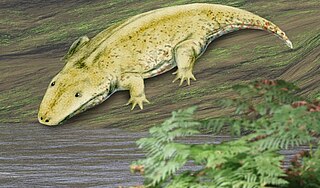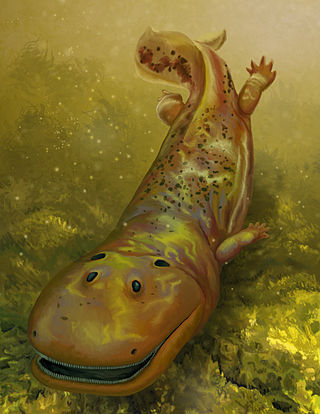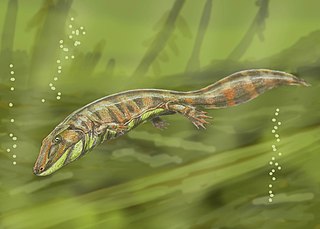
"Labyrinthodontia" is an informal grouping of extinct predatory amphibians which were major components of ecosystems in the late Paleozoic and early Mesozoic eras. Traditionally considered a subclass of the class Amphibia, modern classification systems recognize that labyrinthodonts are not a formal natural group (clade) exclusive of other tetrapods. Instead, they consistute an evolutionary grade, ancestral to living tetrapods such as lissamphibians and amniotes. "Labyrinthodont"-grade vertebrates evolved from lobe-finned fishes in the Devonian, though a formal boundary between fish and amphibian is difficult to define at this point in time.

Lepospondyli is a diverse taxon of early tetrapods. With the exception of one late-surviving lepospondyl from the Late Permian of Morocco, lepospondyls lived from the Early Carboniferous (Mississippian) to the Early Permian and were geographically restricted to what is now Europe and North America. Five major groups of lepospondyls are known: Adelospondyli; Aïstopoda; Lysorophia; Microsauria; and Nectridea. Lepospondyls have a diverse range of body forms and include species with newt-like, eel- or snake-like, and lizard-like forms. Various species were aquatic, semiaquatic, or terrestrial. None were large, and they are assumed to have lived in specialized ecological niches not taken by the more numerous temnospondyl amphibians that coexisted with them in the Paleozoic. Lepospondyli was named in 1888 by Karl Alfred von Zittel, who coined the name to include some tetrapods from the Paleozoic that shared some specific characteristics in the notochord and teeth. Lepospondyls have sometimes been considered to be either related or ancestral to modern amphibians or to Amniota. It has been suggested that the grouping is polyphyletic, with aïstopods being primitive stem-tetrapods, while recumbirostran microsaurs are primitive reptiles.

Dissorophidae is an extinct family of medium-sized temnospondyls that flourished during the late Carboniferous and early Permian periods. The clade is known almost exclusively from North America.

Temnospondyli or temnospondyls is a diverse ancient order of small to giant tetrapods—often considered primitive amphibians—that flourished worldwide during the Carboniferous, Permian and Triassic periods, with fossils being found on every continent. A few species continued into the Jurassic and Early Cretaceous periods, but all had gone extinct by the Late Cretaceous. During about 210 million years of evolutionary history, they adapted to a wide range of habitats, including freshwater, terrestrial, and even coastal marine environments. Their life history is well understood, with fossils known from the larval stage, metamorphosis and maturity. Most temnospondyls were semiaquatic, although some were almost fully terrestrial, returning to the water only to breed. These temnospondyls were some of the first vertebrates fully adapted to life on land. Although temnospondyls are amphibians, many had characteristics such as scales and armour-like bony plates that distinguish them from the modern soft-bodied lissamphibians.

Eucritta is an extinct genus of stem-tetrapod from the Viséan epoch in the Carboniferous period of Scotland. The name of the type and only species, E. melanolimnetes is a homage to the 1954 horror film Creature from the Black Lagoon.

Tulerpeton is an extinct genus of Devonian four-limbed vertebrate, known from a fossil that was found in the Tula Region of Russia at a site named Andreyevka. This genus and the closely related Acanthostega and Ichthyostega represent the earliest tetrapods.

Solenodonsaurus is an extinct genus of reptiliomorphs that lived in what is now Czech Republic, during the Westphalian stage.

Colosteidae is a family of stegocephalians that lived in the Carboniferous period. They possessed a variety of characteristics from different tetrapod or stem-tetrapod groups, which made them historically difficult to classify. They are now considered to be part of a lineage intermediate between the earliest Devonian terrestrial vertebrates, and the different groups ancestral to all modern tetrapods, such as temnospondyls and reptiliomorphs.

Saharastega is an extinct genus of basal temnospondyl which lived during the Late Permian period, around 251 to 260 million years ago. Remains of Saharastega, discovered by paleontologist Christian Sidor at the Moradi Formation in Niger, were described briefly in 2005 and more comprehensively in 2006. The description is based on a skull lacking the lower jaws.

Spathicephalus is an extinct genus of stem tetrapods that lived during the middle of the Carboniferous Period. The genus includes two species: the type species S. mirus from Scotland, which is known from two mostly complete skulls and other cranial material, and the species S. pereger from Nova Scotia, which is known from a single fragment of the skull table. Based on the S. mirus material, the appearance of Spathicephalus is unlike that of any other early tetrapod, with a flattened, square-shaped skull and jaws lined with hundreds of very small chisel-like teeth. However, Spathicephalus shares several anatomical features with a family of stem tetrapods called Baphetidae, leading most paleontologists who have studied the genus to place it within a larger group called Baphetoidea, often as part of its own monotypic family Spathicephalidae. Spathicephalus is thought to have fed on aquatic invertebrates through a combination of suction feeding and filter feeding.

Megalocephalus is an extinct genus of baphetid amphibian from the late Carboniferous of the British Isles and the United States (Ohio). It contains two species, M. pachycephalus and M. lineolatus.

Loxomma is an extinct genus of Loxommatinae and one of the first Carboniferous tetrapods. They were first described in 1862 and further described in 1870 when two more craniums were found. It is mostly associated with the area of the United Kingdom. They share features with modern reptiles as well as with fish. They had 4 paddle-like limbs that they used to swim in lakes, but they breathed air. Their diet consisted mostly of live fish. They are of the family Baphetidae which are distinguished by their keyhole shaped orbits, while Loxomma themselves are distinguished by the unique texture on their skulls, said to be honeycomb-like.

Micropholis is an extinct genus of dissorophoid temnospondyl. Fossils have been found from the Lystrosaurus Assemblage Zone of the Karoo Basin in South Africa and are dated to the Induan. Fossils have also been found from the lower Fremouw of Antarctica.Micropholis is the only post-Permian dissorophoid and the only dissorophoid in what is presently the southern hemisphere and what would have been termed Gondwana during the amalgamation of Pangea.

Ossinodus is an extinct genus of stem tetrapod. Fossils have been found from the Ducabrook Formation in Queensland, Australia dating back to the middle Visean stage of the Early Carboniferous (Mississippian). It was originally placed within the family Whatcheeriidae, but the absence of an intertemporal bone as suggested by a recent reconstruction of the skull based on fragmentary material may prove it to be stemward of all whatcheeriids.

Reptiles arose about 320 million years ago during the Carboniferous period. Reptiles, in the traditional sense of the term, are defined as animals that have scales or scutes, lay land-based hard-shelled eggs, and possess ectothermic metabolisms. So defined, the group is paraphyletic, excluding endothermic animals like birds that are descended from early traditionally-defined reptiles. A definition in accordance with phylogenetic nomenclature, which rejects paraphyletic groups, includes birds while excluding mammals and their synapsid ancestors. So defined, Reptilia is identical to Sauropsida.
Kyrinion is an extinct genus of baphetid tetrapod from the Late Carboniferous of England. It is known from a skull that was found in Tyne and Wear county dating back to the Westphalian stage. Along with the skull is part of the lower jaw, an arch of the atlas bone and a rib possibly belonging to a cervical (neck) vertebra. The type species K. martilli was named from this material in 2003.

Baphetoidea is a superfamily of stem-tetrapods. It includes the family Baphetidae and several more basal genera such as Eucritta and Spathicephalus. The superfamily has also been called Loxommatoidea, but this name is a junior synonym of Baphetoidea.

Caerorhachis is an extinct genus of early tetrapod from the Early Carboniferous of Scotland, probably from the Serpukhovian stage. Its placement within Tetrapoda is uncertain, but it is generally regarded as a primitive member of the group. The type species C. bairdi was named in 1977.

Edopoidea is a clade of primitive temnospondyl amphibians including the genus Edops and the family Cochleosauridae. Edopoids are known from the Late Carboniferous and Early Permian of North America and Europe, and the Late Permian of Africa. They are among the most basal temnospondyls, and possess a number of primitive features that were lost in later members of the group.
Sigournea is a genus of stem tetrapod from the Early Carboniferous. The genus contains only one species, the type species Sigournea multidentata, which was named in 2006 by paleontologists John R. Bolt and R. Eric Lombard on the basis of a single lower jaw from Iowa. The jaw came from a fissure-fill deposit of the St. Louis Limestone that was exposed in a quarry near the town of Sigourney and dates to the Viséan stage, making it approximately 335 million years old. Bolt and Lombard named the genus after Sigourney. The species name multidentata alludes to the many teeth preserved in the jaw. The jaw, which is housed in the Field Museum and cataloged as FM PR 1820, curves strongly downward but was probably straight to begin with, having been deformed by the process of fossilization after the individual died. Rooted in the dentary bone along the outermost edge of the jaw are 88 small, pointed marginal teeth. An additional row of even smaller teeth runs along the coronoids, three bones positioned lengthwise along the lower boundary of the dentary on the inner surface of the lower jaw. Bolt and Lombard were able to classify Sigournea as an early member of Tetrapoda based on the presence of bone surfaces covered in pits and ridges, a single row of dentary teeth, a jaw joint that faces upward, and an open groove for a lateral line along the outer surface of the jaw, and on the absence of teeth on the prearticular bone or enlarged fangs on the coronoids. Sigournea differs from other stem tetrapods in having several holes within a depression called the exomeckelian fenestra on the inner surface of the jaw.


























